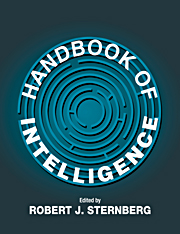Book contents
- Frontmatter
- Contents
- Preface
- Contributors
- PART I THE NATURE OF INTELLIGENCE AND ITS MEASUREMENT
- PART II DEVELOPMENT OF INTELLIGENCE
- PART III GROUP ANALYSES OF INTELLIGENCE
- PART IV BIOLOGY OF INTELLIGENCE
- 10 Animal Intelligence
- 11 The Evolution of Intelligence
- 12 The Neuropsychology and Psychophysiology of Human Intelligence
- PART V INTELLIGENCE AND INFORMATION PROCESSING
- PART VI KINDS OF INTELLIGENCE
- PART VII TESTING AND TEACHING INTELLIGENCE
- PART VIII INTELLIGENCE, SOCIETY, AND CULTURE
- PART IX INTELLIGENCE IN RELATION TO ALLIED CONSTRUCTS
- Author Index
- Subject Index
10 - Animal Intelligence
Published online by Cambridge University Press: 05 June 2012
- Frontmatter
- Contents
- Preface
- Contributors
- PART I THE NATURE OF INTELLIGENCE AND ITS MEASUREMENT
- PART II DEVELOPMENT OF INTELLIGENCE
- PART III GROUP ANALYSES OF INTELLIGENCE
- PART IV BIOLOGY OF INTELLIGENCE
- 10 Animal Intelligence
- 11 The Evolution of Intelligence
- 12 The Neuropsychology and Psychophysiology of Human Intelligence
- PART V INTELLIGENCE AND INFORMATION PROCESSING
- PART VI KINDS OF INTELLIGENCE
- PART VII TESTING AND TEACHING INTELLIGENCE
- PART VIII INTELLIGENCE, SOCIETY, AND CULTURE
- PART IX INTELLIGENCE IN RELATION TO ALLIED CONSTRUCTS
- Author Index
- Subject Index
Summary
ANIMAL INTELLIGENCE
With some justification, humans place themselves at the top of the evolutionary scale. If we rule out the exceptional sensory and response skills of certain nonhuman animals, clearly the sum of our intellectual capacity, measured in almost any way, exceeds that of other animals. The role of our intelligence in the domination of our species over others is clear, but in the broader perspective of evolution, intelligence per se can be viewed quite differently. Our species-centric view of intelligence may be self-serving, but as a general characteristic it correlates only superficially (and perhaps even negatively) with most measures of evolutionary success.
Survival, or more specifically, survival of the genes (Dawkins, 1976) is the measure of evolutionary success. From a purely biological perspective, the ideal survival “machine” is a simple, perhaps one-celled, organism (e.g., bacteria). By some estimates, bacteria, in spite of their small size, account for as much biomass as all other life forms combined, including plants (Gould, 1996). The survival strategy of bacteria is to reproduce quickly and often with sufficient genetic variability to accommodate changes in the environment. This has proven to be a very effective strategy also for more complex organisms like insects and many fishes. An alternative strategy is to invest more in the genetic carrier (the individual organism) and to build within the organism the flexibility required for survival.
Intelligence, in its simplest form, can be thought of as the built-in flexibility that allows individual organisms to adjust their behavior to relatively rapidly changing environments (Stenhouse, 1974, p. 61).
- Type
- Chapter
- Information
- Handbook of Intelligence , pp. 197 - 215Publisher: Cambridge University PressPrint publication year: 2000
- 4
- Cited by



